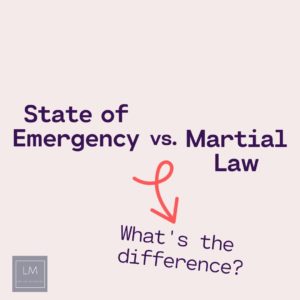
Times are rough for everyone. It is literally life or death. There is so much uncertainty.
What does it actually mean to be in a “state of emergency”? Seems like every city or province is declaring this! What does it mean and how is it different than martial law?
A state of emergency lets the government do things they normally can’t do. Examples – declare a pandemic / tell people to change their normal behaviour. Make people stay indoors. Essentially take away people’s rights and freedoms.

Canada’s Quarantine Act
To really get it, we throw back to 2003 when we had SARS, which none of us really remember because 2003 is more memorable for Ross and Rachel having a baby.
But SARS was a big deal and made Canada draft new emergency management laws from scratch.
This includes Canada’s Quarantine Act.
The name is a dead give away (pun intended) – it is used to legally quarantine people and allows Canada to control international movement of people and goods if there is a health emergency.

This was used for those Canadians who we flew home from Wuhan and to require all travellers coming back to Canada to self-isolate for 14 days.
I think we all got the amber alert earlier.
That’s the Quarantine Act scaring the daylights out of us.

In 2003, Ontario declared a state of emergency but if you thought it was for SARS you are wrong.
That was also the year of the infamous three day black out.
2003 was pretty rough.
The state of emergency allowed Ontario the power to tell all non-essential and non-emergency workers to stay home.
Actually, provinces have declared a state of emergency many times, for big deal things, like the huge fire in Alberta’s Fort McMurray in 2016, or during a bad winter storm.

Martial Law
While Canada has used the Quarantine Act and passed a new bill with an aid package they have not yet declared a national state of emergency (which would be close as to martial law as you would get in this country).
Ontario has a declared a state of emergency under the Emergency Management and Civil Protection Act.
This gives Ontario wide powers: crack down on public gatherings, force closures of businesses, direct resources, get goods and services, fix prices (though “unconscionable prices” are not allowed, ahem – Pusateri’s).

Martial law is where normal (civil) rules are replaced with military authority. Civil liberties are suspended, so anyone can be searched or thrown in prison.
Canada had the War Measures Act, and used it three times but its use fell short of martial law because the courts were administering justice rather than the military.

This Act was replaced in 1988 by the Emergencies Act.
The Emergencies Act has never been used.
Emergencies Act: Canada’s closest thing to Martial Law
The reality is – using the Emergency Act is a big D or in newspeak a “last resort.”
According to CBC : “The act gives powers to the prime minister to respond to four different types of emergency scenarios:
- public welfare (natural disasters, disease),
- public order (civil unrest),
- international emergencies and
- war emergencies.”

It expires automatically after 90 days (unless extension sought).
Trudeau said: “One of the key elements of the Emergencies Act is that it is an override over the provinces. It takes powers that normally are only in the hands of the provinces, or even municipalities, and puts them in the federal level”

For now, Canada has managed to use the Quarantine Act for border issues and have let the provinces run the show.
Canada’s version of martial law, the Emergencies Act, might just be the next step, but at least you’ll know what the heck that means if it happens.
